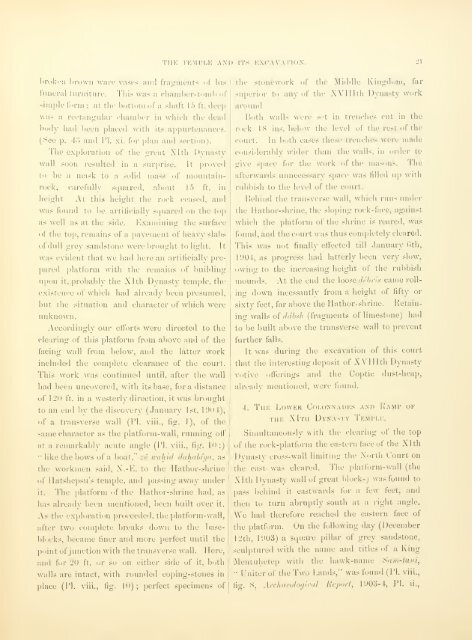The XIth dynasty temple at Deir el-Bahari .. - NYU | Digital Library ...
The XIth dynasty temple at Deir el-Bahari .. - NYU | Digital Library ...
The XIth dynasty temple at Deir el-Bahari .. - NYU | Digital Library ...
Create successful ePaper yourself
Turn your PDF publications into a flip-book with our unique Google optimized e-Paper software.
oki'ii I)rti\vM waix' vases and fragiaciits of his<br />
fuueral kiiiiiturt'. Tliis was a cliainber-tomb of<br />
simple form : <strong>at</strong> tlie bottom of a shaft 15 ft. deep<br />
was a rectangular chamber in which the dead<br />
body had been placed with its appurtenances.<br />
(See p. 4.'^ and PI. xi. for plan and section).<br />
<strong>The</strong> explor<strong>at</strong>ion of the gre<strong>at</strong> Xlth Dynasty<br />
wall soon resulted in a surprise. It proved<br />
to be a mask to a solid mass of mountain-<br />
rock, carefully sijuared, about 1 ."J ft. in<br />
height At this height tlie rock ceased, and<br />
was found to be artiticiallv Sfpiared on the top<br />
as w<strong>el</strong>l as <strong>at</strong> the side. Examining the surface<br />
of the top, remains of a pavement of heavy slabs<br />
of dull grey sandstone were brought to light. It<br />
was evident th<strong>at</strong> we had here an artificially pre-<br />
pared pl<strong>at</strong>form with the remains of building<br />
upon it, probably the Xlth Dynasty <strong>temple</strong>, the<br />
existence of which had ali'eady been presumed,<br />
but the situ<strong>at</strong>ion and character of which were<br />
unknown.<br />
Accordinglv our efforts were directed to the<br />
clearing of this pl<strong>at</strong>form from above and of the<br />
facing wall from b<strong>el</strong>ow, and the l<strong>at</strong>ter work<br />
included the complete clearance of the court.<br />
This work was continued until, after the wall<br />
had been uncovered, with its base, for a distance<br />
of 120 ft. in a westerly direction, it was brought<br />
to an end by the discovery (January 1st, 1904),<br />
of a transverse wall (I'l. viii., fig. 1), of the<br />
same character as the pl<strong>at</strong>form-wall, running oil'<br />
<strong>at</strong> a remarkably acute angle (I'l. viii., fig. 10;)<br />
" like the bows of a bo<strong>at</strong>," ze wahid dahalii/a, as<br />
the workmen said, X.-E. to the H<strong>at</strong>hor-shrine<br />
of H<strong>at</strong>shepsu's <strong>temple</strong>, and passing away under<br />
it. <strong>The</strong> i)l<strong>at</strong>form of the H<strong>at</strong>hor-shrine had, as<br />
lias already been mentioned, been built over it.<br />
As the expk)r<strong>at</strong>ion proceeded, the pl<strong>at</strong>form-wall,<br />
after two complete breaks down to the base-<br />
blocks, became finer and more perfect until the<br />
point of junction with the transverse wall. Here,<br />
and for 20 ft. or so on either side of it, b(jth<br />
walls are intact, with rounded coping-stones in<br />
place (PI. viii., fig. 10) ; perfect specimens of<br />
THE TEMPLE AND ITS EXCAVATION. 21<br />
the stonework of the Middle Kingdom, far<br />
superior to any of the XVIIIth Dynasty work<br />
around.<br />
Both walls were set in trenches cut in the<br />
rock 1 8 ins. b<strong>el</strong>ow the lev<strong>el</strong> of the rest of the<br />
court. In both cases these trenches were made<br />
considerably wider than the walls, in order to<br />
give space for the work of the masons. <strong>The</strong><br />
afterwards unnecessary space was filled up with<br />
rubl)ish to the lev<strong>el</strong> of the court.<br />
Behind the transverse wall, which runs under<br />
the 1 l<strong>at</strong>hor-shrine, the sloping rock-face, against<br />
which the pl<strong>at</strong>form of the shrine is reared, was<br />
found, and the court was thus complet<strong>el</strong>y cleared.<br />
This was not finally effected till January IJth,<br />
1 90-4, as progress had l<strong>at</strong>terly been very slow,<br />
owing to the increasing height of the rulibish<br />
mounds. At the end the loose (h'hris came roll-<br />
ing down incessantly from a height of fifty or<br />
sixty feet, far above the H<strong>at</strong>hor-shrine. Retain-<br />
ing walls of ddbsh (fragments of limestone) had<br />
to be built above the transverse wall to prevent<br />
further falls.<br />
It was during the excav<strong>at</strong>ion of this court<br />
th<strong>at</strong> the interesting deposit of XN'IIlth Dynasty<br />
votive offerings and the Coptic dust-heap,<br />
already mentioned, were found.<br />
4. <strong>The</strong> Lower Colonnades and i;.\.\ii' of<br />
THE <strong>XIth</strong> Dynasty Temi-i.i:.<br />
Simultaneously with the clearing of the top<br />
of the rock-pl<strong>at</strong>form the eastern face of the X Ith<br />
Dynasty cross-wall limiting the North Court on<br />
the east was cleared. <strong>The</strong> pl<strong>at</strong>form- wall (the<br />
Xlth Dynasty wall of gre<strong>at</strong> Ijlocksj was found to<br />
pass behind it eastwards for a few feet, and<br />
then to turn abruptly south <strong>at</strong> a right angle.<br />
We had therefore reached the eastern face of<br />
the pl<strong>at</strong>form. On the following day (December<br />
12th, 1903) a square pillar of grey sandstone,<br />
sculptured with the name and titles of a King<br />
Mentuhetep with the hawk-name Sam-taiii,<br />
" Uuiter of the Two Lands," was found (PI. viii.,<br />
fig. 8, Arckaeological Report, 1903-4, PI. ii..

















